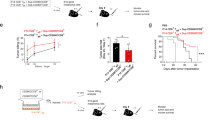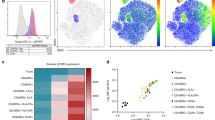Abstract
Autologous transfer of anti-CD3/anti-CD28 (CD3/CD28)-activated CD4+ T cells may benefit patients receiving autologous stem cell transplant with severe CD4 lymphopenia. Interleukin (IL)-15, an IL-2-like cytokine that promotes T cell survival may enhance immune reconstitution in conjunction with adoptive immunotherapy. We investigated the effect of IL-15 on effector and regulatory function of CD3/CD28-activated CD4+ T cells. IL-15 upregulated CD45RO and CD25 whereas it downregulated CD62L expression of CD3/CD28-stimulated CD4+ T cells. Both type 1 (IFN-γ, tumor necrosis factor (TNF)-α) and type 2 (IL-5 and IL-10) production by CD3/CD28-activated CD4+ T cells was further enhanced by IL-15. Co-culture experiments revealed that CD3/CD28-activated CD4+ T cells downregulated proliferation of autologous peripheral blood lymphocytes (PBLs) and CD8+ PBL subsets upon TCR ligation, a contact-dependent effect that was further enhanced by pretreatment with IL-15. Flow cytometric analysis of cell mixture with carboxyfluorescein diacetate succinimidyl ester and Annexin-V-PE staining revealed that CD3/CD28+IL-15-activated CD4+ T cells showed increased apoptosis over CD4+ T cells stimulated with CD3/CD28 alone. Taken together, pretreatment of CD3/CD28-activated CD4+ T cells with IL-15 may increase regulatory function but may aggravate activation-induced apoptosis of CD3/CD28 CD4+ T cells.
This is a preview of subscription content, access via your institution
Access options
Subscribe to this journal
Receive 12 print issues and online access
$259.00 per year
only $21.58 per issue
Buy this article
- Purchase on Springer Link
- Instant access to full article PDF
Prices may be subject to local taxes which are calculated during checkout






Similar content being viewed by others
References
Weinberg K, Annett G, Kashyap A, Lenarsky C, Forman SJ, Parkman R . The effect of thymic function on immunocompetence following bone marrow transplantation. Biol Blood Marrow Transplant 1995; 1: 18–23.
Mackall CL, Stein D, Fleisher TA, Brown MR, Hakim FT, Bare CV et al. Prolonged CD4 depletion after sequential autologous peripheral blood progenitor cell infusions in children and young adults. Blood 2000; 96: 754–762.
Guillaume T, Rubinstein DB, Symann M . Immune reconstitution and immunotherapy after autologous hematopoietic stem cell transplantation. Blood 1998; 92: 1471–1490.
Kalamasz D, Long SA, Taniguchi R, Buckner JH, Berenson RJ, Bonyhadi M . Optimization of human T-cell expansion ex vivo using magnetic beads conjugated with anti-CD3 and anti-CD28 antibodies. J Immunother 2004; 27: 405–418.
Laport GG, Levine BL, Stadtmauer EA, Schuster SJ, Luger SM, Grupp S et al. Adoptive transfer of costimulated T cells induces lymphocytosis in patients with relapsed/refractory non-Hodgkin's lymphoma following CD34-selected hematopoietic cell transplantation. Blood 2003; 102: 2004–2013.
Rapoport AP, Levine BL, Badros A, Meisenberg B, Rhehle K, Nandi A et al. Molecular remission of CML after autotransplantation followed by adoptive transfer of costimulated autologous T cells. Bone Marrow Transplant 2004; 33: 53–60.
Bernstein WB, Cox JH, Aronson NE, Tracy L, Schlienger K, Ratto-Kim S et al. Immune reconstitution following autologous transfers of CD3/CD28 stimulated CD4(+) T cells to HIV-infected persons. Clin Immunol 2004; 111: 262–274.
Eklund JW, Kuzel TM . A review of recent findings involving interleukin-2-based cancer therapy. Curr Opin Oncol 2004; 16: 542–546.
Marchetti G, Franzetti F, Gori A . Partial immune reconstitution following highly active antiretroviral therapy: can adjuvant interleukin-2 fill the gap? J Antimicrob Chemother 2005; 55: 401–409.
Fehniger TA, Caligiuri MA . Interleukin15: biology and relevance to human disease. Blood 2001; 97: 14–32.
Zhang X, Sun S, Hwang I, Tough DF, Sprent J . Potent and selective stimulation of memory-phenotype CD8+ T cells in vivo by IL-15. Immunity 1998; 8: 591–599.
Mueller YM, Makar V, Bojczuk PM, Witek J, Katsikis PD . IL-15 enhances the function and inhibits CD95/Fas-induced apoptosis of human CD4+ and CD8+ effector-memory T cells. Int Immunol 2003; 15: 49–58.
Alpdogan O, Eng JM, Muriglan SJ, Willis LM, Hubbard VM, Tjoe KH et al. Interleukin-15 enhances immune reconstitution after allogeneic bone marrow transplantation. Blood 2005; 105: 865–873.
Rutella S, Pierelli L, Bonanno G, Mariotti A, Sica S, Sora F et al. Immune reconstitution after autologous peripheral blood progenitor cell transplantation: effect of interleukin-15 on T-cell survival and effector functions. Exp Hematol 2001; 29: 1503–1516.
Lyons AB . Analyzing cell division in vivo and in vitrousing flow cytometric measurement of CFSE dye dilution. J Immunol Methods 2000; 243: 147–154.
Levine BL, Bernstein W, Connors M, Craighead N, Linsten T, Thompson CB et al. Effects of CD28 costimulation on long term proliferation of CD4+ T cells in the absence of exogenous feeder cells. J Immunol 1997; 159: 5921–5930.
Borger P, Kauffman HF, Postma DS, Esselink MT, Vellenga E . Interleukin-15 differentially enhances the expression of interferon-gamma and interleukin-4 in activated human (CD4+) T lymphocytes. Immunology 1999; 96: 207–214.
Sallusto F, Lenig D, Forster R, Lipp M, Lanzavecchia A . Two subsets of memory T lymphocytes with distinct homing potentials and effector functions. Nature 1999; 401: 708–712.
Kern PM, Keilholz L, Foster C, Stach C, Beyer TD, Gaipl US et al. UVB-irradiated T-cells undergoing apoptosis lose L-Selectin by metalloprotese-mediated shedding. Int J Radiat Biol 2000; 76: 1265–1271.
Niedbala W, Wei X, Liew FY . IL-15 induces type 1 and type 2 CD4+ and CD8+ T cells proliferation but is unable to drive cytokine production in the absence of TCR activation or IL-12/IL-4 stimulation in vitro. Eur J Immunol 2002; 32: 341–347.
Kanegane H, Kasahara Y, Niida Y, Yachie A, Sughii S, Takatsu K et al. Expression of L-Selectin (CD62L) discriminates Th1- and Th2-like cytokine-producing memory CD4+ T cells. Immunology 1996; 87: 186–190.
Matsuzaki S, Shinozaki K, Kobayashi N, Agematsu K . Polarization of Th1/Th2 in human CD4T cells separated by CD62L: analysis by transcription factors. Allergy 2005; 60: 780–787.
Pandiyan P, Gärtner D, Soezeri O, Radbruch A, Schulze-Osthoff K, Brunner-Weinzierl MC . CD152 (CTLA4) determines the unequal resistance of Th1 and Th2 cells against activation induced cell death by a mechanism requiring PI3 kinase function. J Exp Med 2004; 199: 831–842.
Zhang X, Brunner T, Carter L, Dutton RW, Rogers P, Bradley L et al. Unequal death in T helper cell (Th)1 and Th2 effectors: Th1, but not Th2, effectors undergo rapid Fas/FasL-mediated apoptosis. J Exp Med 1997; 185: 1837–1849.
Baecher-Allan C, Viglietta V, Hafler DA . Human CD4+ CD25+ regulatory T cells. Semin Immunol 2004; 16: 89–98.
Wing K, Suri-Payer E, Rudin A . CD4+CD25+-regulatory T cells from mouse to man. Scand J Immunol 2005; 62: 1–15.
Levings MK, Roncarolo MG . T-regulatory 1 cells: a novel subset of CD4+ T cells with immunoregulatory properties. J Allegy Clin Innumol 2000; 106: S109–S112.
Curotto de Lafaille MA, Lino AC, Kutchukhidze N, Lafaille JJ . CD25− T cells generate CD25+Foxp3+ regulatory T cells by peripheral expansion. J Immunol 2004; 173: 7259–7268.
Rao PE, Petrone AL, Ponath PD . Differentiation and expansion of T cells with regulatory function from human peripheral lymphocytes by stimulation in the presence of TGF-β. J Immunol 2005; 174: 1446–1455.
Koenen HJ, Fasse E, Joosten I . IL-15 and cognate antigen successfully expand de novo-induced human antigen-specific regulatory CD4+ T cells that require antigen-specific activation for suppression. J Immunol 2003; 171: 6431–6441.
Szanya V, Ermann J, Taylor C, Holness C, Fathman CG . The subpopulation of CD4+CD25+ splenocytes that delays adoptive transfer of diabetes expresses L-Selectin and high levels of CCR7. J Immunol 2002; 169: 2461–2465.
Ermann J, Hoffmann P, Edinger M, Dutt S, Blankenberg FG, Higgins JP et al. Only the CD62L+ subpopulation of CD4+CD25+ regulatory T cells protects from lethal acute GVHD. Blood 2005; 105: 2220–2226.
Saff RR, Spanjaard ES, Hohlbaum AM, Marshak-Rothstein A . Activation-induced cell death limits effector function of CD4 tumor-specific T cells. J Immunol 2004; 172: 6598–6606.
Maher SG, Condron CEM, Bouchier-Hayes DJ, Toome DM . Taurine attenuates CD3/interleukin-2-induced T cell apoptosis in an in vitro model of activation-induced cell death (AICD). Clin Exp Immunol 2005; 139: 279–286.
Fritzsching B, Oberle N, Eberhardt N, Quick S, Haas J, Wildemann B et al. In contrast to effector T cells, CD4+CD25+FoxP3+ regulatory T cells are highly susceptible to CD95 ligand- but not to TCR-mediated cell death. J Immunol 2005; 175: 32–36.
Longhi MS, Ma Y, Mitry RR, Bogdanos DP, Heneghan M, Cheeseman P et al. Effect of CD4+CD25+ regulatory T-cells on CD8 T-cell function in patients with autoimmune hepatitis. J Autoimmun 2005; 25: 63–71.
Acknowledgements
This study was supported by grants from the National Science Council of Republic of China (grant number NSC93-2314-B-182A-073 and NSC94-2314-B-182A-095) and a grant from the Chang-Gung Memorial Hospital (grant number CMRPG 32024).
Author information
Authors and Affiliations
Corresponding author
Rights and permissions
About this article
Cite this article
Lin, SJ., Cheng, PJ. & Hsiao, SS. Effect of interleukin-15 on effector and regulatory function of anti-CD3/anti-CD28-stimulated CD4+ T cells. Bone Marrow Transplant 37, 881–887 (2006). https://doi.org/10.1038/sj.bmt.1705348
Received:
Revised:
Accepted:
Published:
Issue Date:
DOI: https://doi.org/10.1038/sj.bmt.1705348



